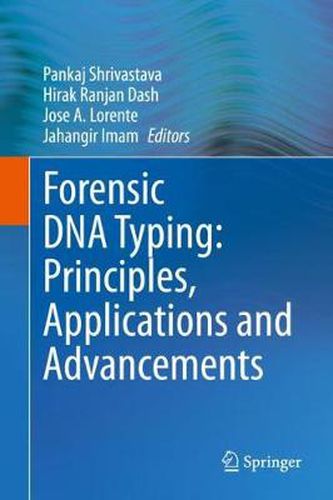Readings Newsletter
Become a Readings Member to make your shopping experience even easier.
Sign in or sign up for free!
You’re not far away from qualifying for FREE standard shipping within Australia
You’ve qualified for FREE standard shipping within Australia
The cart is loading…






This title is printed to order. This book may have been self-published. If so, we cannot guarantee the quality of the content. In the main most books will have gone through the editing process however some may not. We therefore suggest that you be aware of this before ordering this book. If in doubt check either the author or publisher’s details as we are unable to accept any returns unless they are faulty. Please contact us if you have any questions.
The book explores the fundamental principles, advances in forensic techniques, and its application on forensic DNA analysis. The book is divided into three modules; the first module provides the historical prospect of forensic DNA typing and introduces fundamentals of forensic DNA typing, methodology, and technical advancements, application of STRs, and DNA databases for forensic DNA profile analysis.
Module 2 examines the problems and challenges encountered in extracting DNA and generating DNA profiles. It provides information on the methods and the best practices for DNA isolation from forensic biological samples and human remains like ancient DNA, DNA typing of skeletal remains and disaster victim identification, the importance of DNA typing in human trafficking, and various problems associated with capillary electrophoresis.
Module 3 emphasizes various technologies that are based on SNPs, STRs namely Y-STR, X-STR, mitochondrial DNA profiling in forensic science. Module 4 explores the application of non-human forensic DNA typing of domestic animals, wildlife forensics, plant DNA fingerprinting, and microbial forensics.
The last module discusses new areas and alternative methods in forensic DNA typing, including Next-Generation Sequencing, and its utility in forensic science, oral microbes, and forensic DNA phenotyping.
Given its scope, the book is a useful resource in the field of DNA fingerprinting for scientists, forensic experts, and students at the postgraduate level.
$9.00 standard shipping within Australia
FREE standard shipping within Australia for orders over $100.00
Express & International shipping calculated at checkout
This title is printed to order. This book may have been self-published. If so, we cannot guarantee the quality of the content. In the main most books will have gone through the editing process however some may not. We therefore suggest that you be aware of this before ordering this book. If in doubt check either the author or publisher’s details as we are unable to accept any returns unless they are faulty. Please contact us if you have any questions.
The book explores the fundamental principles, advances in forensic techniques, and its application on forensic DNA analysis. The book is divided into three modules; the first module provides the historical prospect of forensic DNA typing and introduces fundamentals of forensic DNA typing, methodology, and technical advancements, application of STRs, and DNA databases for forensic DNA profile analysis.
Module 2 examines the problems and challenges encountered in extracting DNA and generating DNA profiles. It provides information on the methods and the best practices for DNA isolation from forensic biological samples and human remains like ancient DNA, DNA typing of skeletal remains and disaster victim identification, the importance of DNA typing in human trafficking, and various problems associated with capillary electrophoresis.
Module 3 emphasizes various technologies that are based on SNPs, STRs namely Y-STR, X-STR, mitochondrial DNA profiling in forensic science. Module 4 explores the application of non-human forensic DNA typing of domestic animals, wildlife forensics, plant DNA fingerprinting, and microbial forensics.
The last module discusses new areas and alternative methods in forensic DNA typing, including Next-Generation Sequencing, and its utility in forensic science, oral microbes, and forensic DNA phenotyping.
Given its scope, the book is a useful resource in the field of DNA fingerprinting for scientists, forensic experts, and students at the postgraduate level.